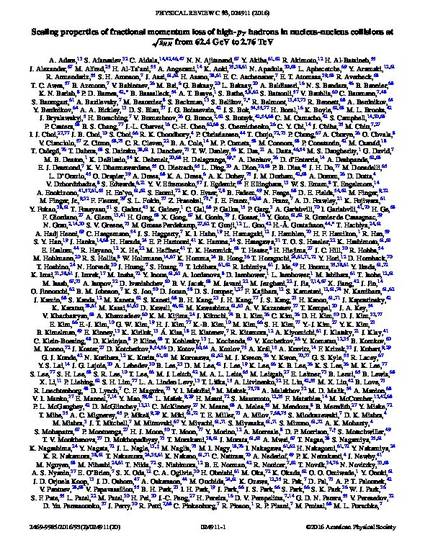
Article
Scaling properties of fractional momentum loss of high-p(T) hadrons in nucleus-nucleus collisions at root s(NN) from 62.4 GeV to 2.76 TeV
Physical Review C
Document Type
Article
Publication Version
Published Version
Publication Date
2-22-2016
DOI
10.1103/PhysRevC.93.024911
Abstract
Measurements of the fractional momentum loss (S-loss = delta p(T) / p(T)) of high-transverse-momentum-identified hadrons in heavy-ion collisions are presented. Using pi(0) in Au + Au and Cu + Cu collisions at root s(NN) = 62.4 and 200 GeV measured by the PHENIX experiment at the Relativistic Heavy Ion Collider and and charged hadrons in Pb + Pb collisions measured by the ALICE experiment at the Large Hadron Collider, we studied the scaling properties of S-loss as a function of a number of variables: the number of participants, N-part, the number of quark participants, N-qp, the charged-particle density, dN(ch)/d(eta), and the Bjorken energy density times the equilibration time, epsilon(Bj)tau(0). We find that the p(T), where S-loss has its maximum, varies both with centrality and collision energy. Above the maximum, S-loss tends to follow a power-law function with all four scaling variables. The data at root s(NN) = 200 GeV and 2.76 TeV, for sufficiently high particle densities, have a common scaling of S-loss with dN(ch)/d(eta) and epsilon(Bj)tau(0), lending insight into the physics of parton energy loss.
Copyright Owner
American Physical Society
Copyright Date
2016
Language
en
File Format
application/pdf
Citation Information
Andrew Adare, Sarah C. Campbell, Lei Ding, Alan Dion, et al.. "Scaling properties of fractional momentum loss of high-p(T) hadrons in nucleus-nucleus collisions at root s(NN) from 62.4 GeV to 2.76 TeV" Physical Review C Vol. 93 Iss. 2 (2016) p. 024911 Available at: http://works.bepress.com/craig-ogilvie/47/

This is an article from Physical Review C 93 (2016): 024911, doi:10.1103/PhysRevC.93.024911. Posted with permission.